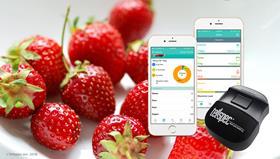
Being able to scan a piece of fruit and predict a) what it will taste like and b) how long it will last might sound like magic, but that is exactly what a growing number of technology companies are claiming their devices can do.
Most of the press coverage on food scanners has centred on tools to check for chemicals, allergens and ingredients you’d rather avoid, but in fresh produce the focus is on things like fruit ripeness, maturity, shelf life and Brix. In layman’s terms this is achieved by beaming infrared waves at a fruit or vegetable using a tungsten or LED light and detecting the vibrations that are reflected back – a method known as near-infrared spectroscopy.
Although the range of fruits that the scanners can be used on varies between devices, the general rule is that they work better on products with thinner skin since it is easier for the radiation to penetrate. Mangoes, apples, pears, kiwi, tomatoes, plums, nectarines, cherries, berries, grapes and peppers are among the products that can be scanned.
The benefits of being able to quality control a batch of fruit without having to cut into it and carefully test samples are evident: you waste less fruit, you save a great deal of time and you minimise human error, with little need for specialist expertise. And these aren’t the only advantages – tech firms like Tellspec have also designed an app, which connects to their scanner via Bluetooth and gives immediate real-time results. A fruit quality report can be issued automatically and either emailed to the user or provided in excel format.
“My hope is that food scanners lead to higher quality standards,” says Simon Goisser of Hochschule Weihenstephan-Triesdorf in Bavaria, who has been researching ways of measuring fresh produce with the devices. “Perhaps food scanners will mean internal quality and taste improve, and maybe this will lead to new varieties with better taste,” he adds. “Maybe in a few years we won’t need to scan the fruit every day because the overall quality will be really good.”
As well as helping to drive up quality, there is also scope to limit food waste, Goisser believes. With the ability to estimate shelf life more accurately, suppliers, retailers and consumers will hopefully be able to make sure food is sold, used or repurposed at the right time. It is even possible to lengthen a fruit’s shelf life, by using a food scanner to precisely measure its ripeness and make sure it’s harvested at the optimal moment.
All of this assumes that the people know how to operate the scanners and interpret the data, however. And there are concerns that when they are made more widely available to consumers, they might actually add to food waste if people wrongly assume a fruit is no longer good to eat because it falls outside a narrow range of readings.
Further limitations lie in the accuracy of some of the devices, with plenty of work still to be done to make them a reliable tool. Inevitably there tends to be a trade off between the size and accuracy of a device, and some of the smaller models are generally considered to have less sensitivity than the larger, more expensive models on the market.
One of the more advanced providers is US firm Felix Instruments, which offers several different devices for postharvest and food scientists, including handheld gas analysers and portable fruit quality meters. “Our F-750 Produce Quality Meter allows users to see through the skin of the fruit into the flesh and further analyses the composition to report sugar, acidity, water content and dry matter and many other significant characteristics,” says the company’s president Leonard Felix. “Meanwhile, our Gas Analysers allow fresh produce handlers to manage ethylene, CO2, oxygen and humidity either to promote or to suspend ripening. Next to temperature, ripening gasses have the largest impact on the rate of ripening.”
Felix Instruments says these devices are already being used by some of the largest citrus, apple, avocado and mango growers in California, Mexico, Europe, Israel and Asia. And the company’s largest markets in 2017 were China and Mexico, with the business making 80 per cent of its sales outside the US. But as food scanners become more widely known and used, there are also concerns that the inaccuracy of some devices is damaging the sector’s reputation and killing the market.
“The biggest problem we have in the industry is that there are some groups putting out cheap and inaccurate devices, while others design technology that is reliable but costs almost ten times as much,” says Tellspec’s chief executive and founder Isabel Hoffmann. “Of course people say well I’ll buy the cheaper one, but then they realise the scanner isn’t accurate enough and either have to spend more money on a better model or give up on food scanners completely.”
In China it is already possible for consumers to have a sensor attached to the back of their smartphone and linked to an app so they can scan fruit themselves in store. But before the technology is rolled out to shoppers, there is still progress to be made on the industry-standard devices and time to wait until the parts become cheap enough to offer a good tool to the consumer and not just a gadget.
“This has to go first B2B and then B2C,” says Hoffmann. “Most consumers don’t even understand the word Brix so there’s a huge amount of work to do.”






No comments yet